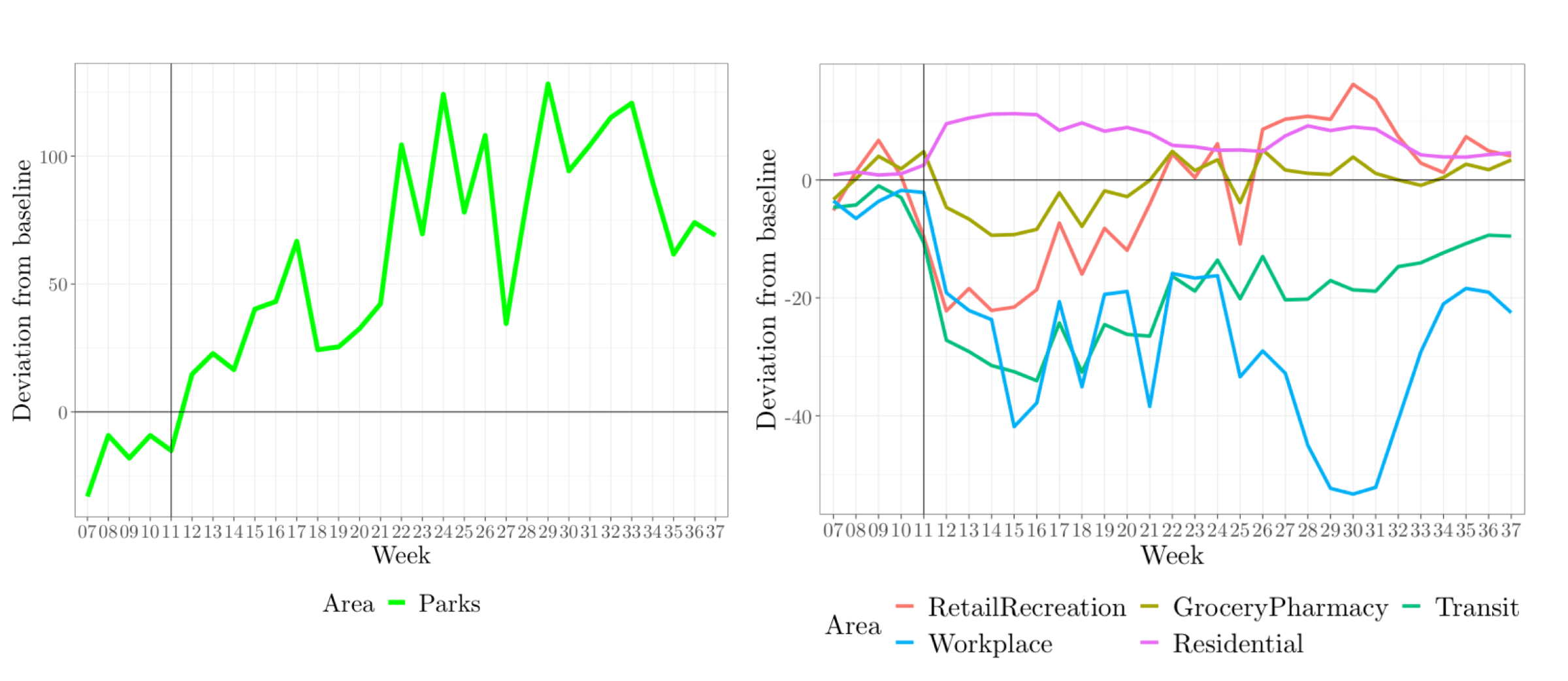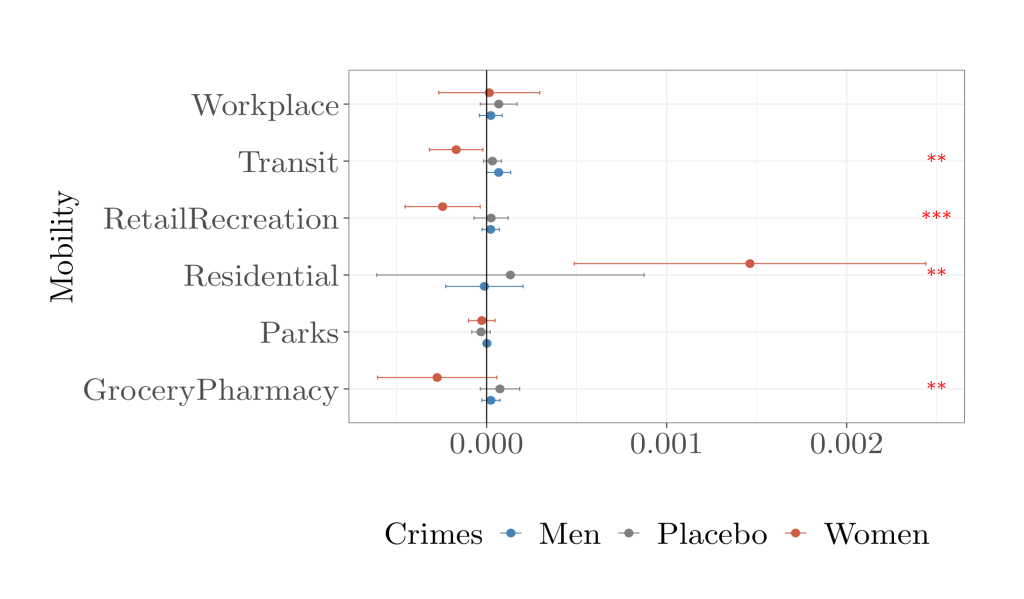Domestic violence – the case of Sweden during the pandemic
Domestic violence in the time of Covid-19
Since the outbreak of Covid-19 in the spring of 2020, media outlets around the world have reported increases in domestic violence. United Nations secretary-general António Guterres has even referred to it as a “shadow pandemic”. Besides news outlets, academic researchers have also taken an interest in the issue, which is crucial if we are to draw the right conclusions from the patterns we see in the statistics. Preliminary evidence shows that the incidence of intimate partner violence has also increased in Sweden, notwithstanding the absence of a strict lockdown. This is likely related to the socio-economic changes brought about by the pandemic.
A Shadow pandemic?
In response to the Covid-19 pandemic, governments around the world introduced a variety of measures aimed to stave off the contagion, and billions of worried people adapted their behavior and lifestyle. But did the pandemic, and the changes brought by it, also lead to an increase in domestic violence?
Were we to simply look at the number of domestic violence offenses reported over time, we would not be able to answer this question. Historical trends and seasonal patterns in domestic violence would confound this observation, while the crisis might affect the reporting of crimes independently of their occurrence. More rigorous statistical analysis is needed for understanding not only the true situation with domestic violence under the pandemic, but also the reasons behind it. Investigating the driving factors is crucial for informing policy reactions already in the short run — is it a loss of income that generates violence, or could it simply be increased exposure? Do we need more unemployment benefits or shelters for victims? Moreover, the rather special conditions created by the pandemic can contribute to our general understanding of how domestic violence occurs in relation to other societal dynamics, unveil some of the causal mechanisms that are still open questions in the literature and help to fight this issue further, even after the pandemic is over.
Socio-economic theories of violence
Within social science research, studies that focus on the relationship between domestic violence and factors at a societal level can be divided into several different branches. A large corpus of theories interprets violence as a result of power imbalance within households. This perspective is associated with explanations such as bargaining power, exit options, and status, theoretical concepts that are often embodied and approximated by observable factors such as (relative) education, income or employment status. For example, Aizer (2010) provides results in line with the bargaining power hypothesis showing that a decrease in the gender wage gap in the US is associated with a decrease in domestic violence against women. Along the same lines, Anderberg et al. (2016) use UK data to show that an increase in unemployment among men reduces the incidence of intimate partner violence (IPV) while an increase in unemployment among women increases it. In contrast, a study from Spain documents the opposite relationship in provinces characterized by stronger traditional gender roles (Tur-Prats, 2019). It finds that a decrease in female relative to male unemployment causes an increase in violence, which is more in line with the “backlash explanation” — when a woman improves her economic position and independence, the man in the household feels that his identity as breadwinner is threatened and retaliates with violence as a result. Studies such as Iyer et al. (2012) and Miller and Segal (2018) highlight the importance of improving the position of women in society, which can be achieved, for example, through role models and female representation in critical positions. They associate the proportion of women among elected politicians and among the police, in India and the United States respectively, with a significant increase in reports of crimes against women and at the same time a significant decrease in the incidence of such crimes.
An alternative interpretation of domestic violence puts more emphasis on its emotional and irrational nature. In this case, particular events or negative emotional shocks, such as an unexpected negative result of an important football match (Card and Dahl, 2011), are believed to trigger violent reactions in the heat of the moment. The likelihood of such incidents is exacerbated by stress and emotional climate within a household, which in turn are influenced by economic conditions or financial uncertainty. For example, several studies from developing countries associate improvements in general economic conditions with a reduction in domestic violence (Hidrobo et al., 2016; Kim et al., 2007; Haushofer et al., 2019).
Finally, there is a common perception that domestic violence increases during holidays and weekends as families spend more time together and potential victims are more isolated from their social networks, in line with the so-called exposure model in criminology. So far, research on this hypothesis is limited and incomplete. However, it is precisely one of the areas where studies from the recent months may fill the knowledge gap: the fact that lockdowns and work from home forced many families to spend more time together at home while retaining full wages, gives a unique opportunity to examine exposure in isolation from other economic factors.
The opposite of exposure is known as (self-) incapacitation theory: no aggression will occur while a (potentially violent) partner is occupied with something else, whether imposed or self-chosen. Several studies focusing on this hypothesis have documented that the incidence of violent crimes declines, on the street or in the home environment, when potential perpetrators are in school (Jacob and Lefgren, 2003), in prison (Levitt, 1996), at the cinema (Dahl and DellaVigna, 2009) and when they have access to a legal prostitution market (Cunningham and Shah, 2018; Ciacci and Sviatschi, 2018; Berlin et al., 2019). During a lockdown, the availability of such activities is restricted, both to violent people as well as potential victims.
Research on domestic violence during Covid-19
The list of studies analyzing data from the past few months is growing by the day. Although full consensus is yet to be reached, the results that have emerged point towards a few patterns: spikes in domestic violence can be credibly connected to strict limitations of movement, at least in some contexts (India, Ravindran and Shah, 2020; Peru, Agüero, 2020; 15 large US cities, Leslie and Wilson, 2020); unemployment could be an important mechanism (Bhalotra et al., 2020; in Canada, Beland et al., 2020 find no impact of unemployment or work arrangements per se, but do associate spikes in violence to financial difficulties); alcohol does not seem to amplify domestic violence during the pandemic, at least in some context (Silverio-Murillo and Balmori de la Miyar do not find any effect of the prohibition to sell alcohol in parts of Mexico City); and by and large barriers to reporting might be a serious issue (Spencer et al, 2020).
A selection of studies on domestic violence during the Covid-19 crisis, many of which are as yet unpublished, were presented at the recent FROGEE Workshop “Economic Perspectives on Domestic Violence”. Two FREE Policy Briefs summarizing the event are forthcoming.
Domestic violence in Sweden during Covid-19
Studying Sweden against this background can be particularly interesting for at least two reasons. Sweden regularly occupies the top positions in international rankings of gender equality in many dimensions and is seen as having advanced progressive norms and attitudes in this area. As pointed out by the literature on the economic determinants of domestic violence, underlying norms and attitudes can play a significant role in shaping the impact of other factors, such as unemployment (Tur-Prats, 2019). Therefore, the Swedish case can offer a valuable comparison to studies focusing on countries that have different attitudes and norms.
According to estimates by the National Council for Crime Prevention (BRÅ), at least 7% of the Swedish population is exposed yearly to domestic violence, both men and women in roughly equal parts. However, women are much more likely to report recurring violence and to end up hospitalized.
When it comes to the particular situation of the Covid-19 crisis, Sweden is also close to unique in its contagion-management strategy. Swedish policy relied much more than elsewhere on voluntary participation and individual responsibility rather than coercion. Certainly, working from home when possible was encouraged, the use of public transport discouraged, and indoor events with more than 500, and thereafter 50 participants were forbidden, which included many sports and cultural events. In fact, the Google mobility index, based on location data from Google Account users, shows patterns of clear deviation from the baseline since week 11 of 2020, when the authorities declared a very high risk of community spread.
Figure 1. Mobility patterns in Sweden during Covid-19

Source: Author’s aggregation of Google mobility index. The lines show the deviation from baseline, in percentual terms, of total user presence in different urban areas by category.
The plots in Figure 1 show that the presence of Google Account users was about 10% higher in residential areas (the pink line) and much lower in workplaces, despite some variation over the period: the initial decline was roughly half as large as the impact of summer vacation, as shown by the blue line. Also, visits to retail centers and grocery stores, recreation places (such as restaurants, cinemas, and theaters), and transit stations decreased, especially during the beginning of the period. Mobility in parks and green areas, shown separately, follow to a larger extent a seasonal pattern.
Nevertheless, the general population was never forbidden or even discouraged from leaving their homes, which clearly makes a stark difference for many of the mechanisms that, based on the literature, we think could play a role in explaining domestic violence.
According to BRÅ, during the first half of 2020, there was a 1% increase in total reported crime compared to the same period of the previous year. However, there is wide variation among the crime categories: 9% more violent assaults against women were reported, and 4% more against men, but 6% fewer rapes of women and 9% fewer rapes of men. As discussed above, it is not straightforward to draw conclusions from simple comparisons over time. Preliminary analysis utilizing the variation in mobility patterns over weeks and municipalities reveals that a 10% increase in residential mobility is associated with a (lower bound) increase in reported non-battery crimes against women committed by an intimate partner by 0.015 crimes per 10,000 individuals (a sixth of the mean). The corresponding figure for a 10% reduction in mobility in retail and recreation areas and transit mobility is around 0.0025 additional crimes (3% of the mean) (see Figure 2). Crime categories include attempted or planned homicides; sexual molestations, sexual assaults, and rapes; violations of integrity and privacy (including limitation of freedom, coercion, threats, persecutions; battery crimes are not included for the time being because of a coding mistake in the police system pertaining this particular category).
Figure 2. Mobility patterns and IPV in Sweden during Covid-19 – non-battery crimes

Source: Author’s analysis. Crime data provided by the police, mobility index provided by Google.
We consider this a lower bound because of the voluntary nature of the Swedish ”lockdown” – if people have the freedom to choose, then it is reasonable to expect that individuals more exposed to the risk of domestic violence would decide to be less at home, which would reduce the strength of the relationship observed. In the opposite direction, we might be worried that when more people are at home, more crimes are reported by a third party, such as neighbors, and thus not implying that more crimes are being committed. However, we differentially see more reported crimes with a female victim than with a male victim, which is not necessarily easy for a third party to distinguish by the sounds. Therefore, it seems likely that, based on the changes in mobility patterns, IPV against women has increased in Sweden during the Covid-19 crisis. Other consequences of the crisis that might also play an important role in shaping IPV and domestic violence, including the huge increase in unemployment and changes in alcohol sales, remain to be investigated.
Conclusion
In conclusion, research from the past months finds some limited support for hypotheses originating from previous literature on the relationship between different socio-economic factors and domestic violence. When these factors were affected by the pandemic and the associated economic crisis, domestic violence responded as well, to a varying extent depending on the context. This can be seen as an indirect and hidden cost of the pandemic.
Preliminary evidence indicates a similar case for Sweden, notwithstanding the absence of a strict lockdown. This implies that a significant part of the changes in behavior, which in turn can be expected to affect domestic violence, have occurred as a response to the pandemic itself and not necessarily as a result of policy measures.
While the shock of the pandemic will help us to better understand some of the underlying mechanisms behind the phenomenon of domestic violence, many questions are still open, and it is important to look beyond the pandemic. Domestic violence existed before Covid-19 and will, unfortunately, remain part of our societies when the pandemic is over. Investigating and understanding its determinants is important in order to formulate proper policies to combat it during and after the crisis.
References
Agüero, Jorge M, 2020. “Covid-19 and the rise of intimate partner violence”. Unpublished.
Aizer, Anna, 2010. “The Gender Wage Gap and Domestic Violence.”, The American economic review, 100 (4), 1847-1859.
Anderberg, Dan; Helmut Rainer; Jonathan Wadsworth; and Tanya Wilson, 2016. “Unemployment and Domestic Violence: Theory and Evidence.”, The Economic Journal, 126 (597), 1947–1979.
Béland, Louis-Philippe; Abel Brodeur; and Taylor Wright, 2020. “The short-term economic consequences of Covid-19: exposure to disease, remote work and government response.” Unpublished.
Berlin, Maria P.; Giovanni Immordino, Francesco F. Russo and Giancarlo Spagnolo, 2020. “Prostitution and Violence. Empirical Evidence from Sweden”, Unpublished.
Berlin, Maria P.; and Manne Gerell, 2020. “Economic Determinants of Violence in the Home: The Case of Sweden During Covid-19”, Unpublished.
Bhalotra, Sonia; Damian Clarke; Emilia Brito; Pilar Larroulet; and Francisco Pino, 2020. “Impact of Covid-19 on Domestic Violence, Crime and Male and Female Time Use and Labor Supply: Evidence from Rolling Quarantines in Chile”, Unpublished.
Capaldi, Deborah M.; Naomi B. Knoble, Joann Wu Shortt, and Hyoun K. Kim, 2012. “A systematic review of risk factors for intimate partner violence.” Partner abuse 3, no. 2. 231-280.
Card, David; and Gordon B. Dahl, 2011. “Family violence and football: The effect of unexpected emotional cues on violent behavior.” The quarterly journal of economics. 126.1, 103-143.
Ciacci, Riccardo; and Maria Micaela Sviatschi, 2016. ”The Effect of Indoor Prostitution on Sex Crime: Evidence from New York City”, Columbia University Working Paper.
Cunningham, Scott; and Manisha Shah, 2017. “Decriminalizing indoor prostitution: Implications for sexual violence and public health.” The Review of Economic Studies, 85.3, 1683-1715.
Dahl, Gordon; and Stefano DellaVigna, 2009. “Does movie violence increase violent crime?”, The Quarterly Journal of Economics. 124.2 (2009): 677-734.
Haushofer, Johannes, Charlotte Ringdal, Jeremy P. Shapiro, and Xiao Yu Wang, 2019. “Income changes and intimate partner violence: Evidence from unconditional cash transfers in Kenya”, Unpublished.
Hidrobo, Melissa; Amber Peterman, and Lori Heise, 2016 “The effect of cash, vouchers, and food transfers on intimate partner violence: evidence from a randomized experiment in Northern Ecuador.” American Economic Journal: Applied Economics. 8, no. 3. 284-303.
Iyer, Lakshmi; A. Mani, P. Mishra, & P. Topalova, 2012.”The power of political voice: women’s political representation and crime in India.” American Economic Journal: Applied Economics 4.4, 165-93.
Jacob, Brian, A.; and Lars Lefgren, 2003. “Are Idle Hands the Devil’s Workshop? Incapacitation, Concentration, and Juvenile Crime.” American Economic Review, 93 (5): 1560-1577.
Kim, Julia C.; Charlotte H. Watts, James R. Hargreaves, Luceth X. Ndhlovu, Godfrey Phetla, Linda A. Morison, Joanna Busza, John DH Porter, and Paul Pronyk, 2007. “Understanding the impact of a microfinance-based intervention on women’s empowerment and the reduction of intimate partner violence in South Africa.” American journal of public health. 97, no. 10. 1794-1802.
Levitt, Steven D., “The Effect of Prison Population Size on Crime Rates: Evidence from Prison Overcrowding Litigation”. The Quarterly Journal of Economics, Volume 111, Issue 2, May 1996, Pages 319–351.
Leslie, Emily; and Riley Wilson, 2020. “Sheltering in place and domestic violence: Evidence from calls for service during COVID-19.” Unpublished.
Miller, Amalia R.; and Carmit Segal, 2018. “Do Female Officers Improve Law Enforcement Quality? Effects on Crime Reporting and Domestic Violence.” The Review of Economic Studies.
Ravindran, Saravana; and Manisha Shah, 2020. ”Unintended consequences of lockdowns: Covid-19 and the shadow pandemic.” Unpublished.
Silverio-Murillo, Adan; Jose Roberto Balmori de la Miyar; and Lauren Hoehn-Velasco, 2020. “Families under confinement: Covid-19, domestic violence, and alcohol consumption.” Unpublished.
Spencer, Melissa; Amalia Miller; and Carmit Segal, 2020. “Effects of the COVID-19 Pandemic on Domestic Violence in US Cities.” Unpublished.
Tur-Prats, Ana, 2019. “Family Types and Intimate Partner Violence: A Historical Perspective”. Review of Economics and Statistics, 101(5), 878-891.
Disclaimer: Opinions expressed in policy briefs, working papers and other publications are those of the authors; they do not necessarily reflect those of SITE, the FREE Network and its research institutes.
Watch the presentation hosted by Utbildningsradion (UR) as Assistant Professor Maria Perrotta Berlin shares her insights on why domestic violence have increased since the start of COVID-19 pandemics.
Or watch Maria's webinar presentation "Economic Determinants of Violence in the Home: The Case of Sweden during Covid-19" on our YouTube channel. See the short teaser below!




